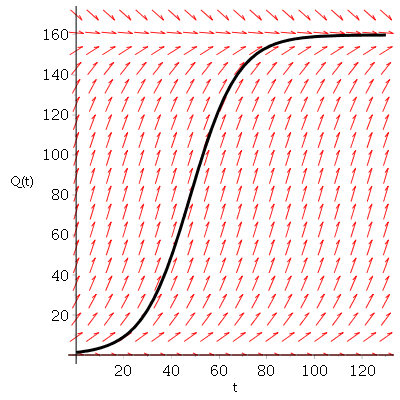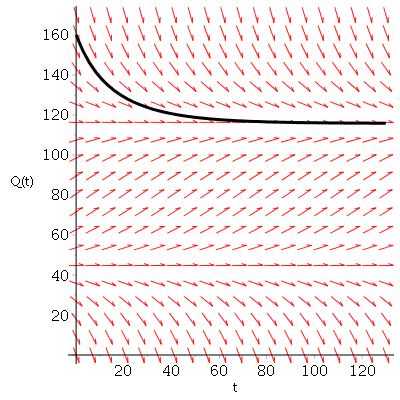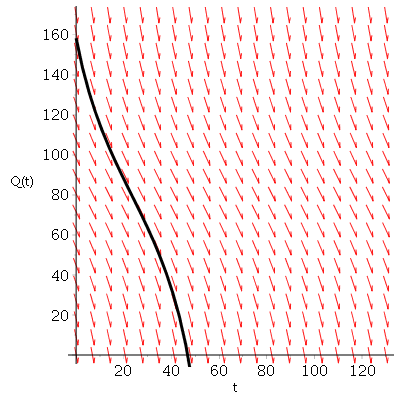MATH 136 -- Calculus 2
Lab 3 -- Logistic Models with Harvesting (Environmental Modeling)
November 14 and 16, 2016
Question A: The logistic equation and the solution with Q(0) = 1.3 Mg
![]()
| (1) |
![]()
![]()
 |
A 2) The formula for the solution of the logistic equation is:
![]()
| (2) |
![]()
| (3) |
![]()
| (4) |
These are the biomass values at the times t = 0, 10, 20, ... , 150 years:
![]()
| (5) |
A 3) The recovery time is the time it takes the forest to regrow to 99% of the carrying capacity, or (.99)(160) = 158.4:
![]()
| (6) |
Thus the recovery time is about 94 years.
B)
1) The "virgin state" would be represented by the initial value Q(0) = 160.
2 and 3) With 3.2 Mg of biomass harvested each year, the differential equation becomes:
![]()
| (7) |
![]()
 |
4) Note that the solution seems to be tending to a limiting value of about Q = 116 as ![]()
5) With the harvesting level at 6.4 Mg/year, the differential equation becomes
![]()
| (8) |
![]()
 |
The solution reaches the value Q = 0 at about t = 47 years. At that time, all the biomass in the forest
has been removed.
C) To find the equilibria of these differential equations with the harvesting terms, we need to
set the right-hand sides equal to zero and solve for Q. This can be done in Maple as follows.
For the harvesting level of 3.2 Mg/year, we use:
| > |
| (9) |
![]() in the plot of the solutions for the equation with the harvesting
in the plot of the solutions for the equation with the harvesting
level of 3.2 Mg/year above. The solutions tend toward the 115.78 level, they tend away from the 44.22
level. These values can also be derived by using the quadratic formula to solve this quadratic equation
for Q: ![]()
| > | (-.1 + sqrt((.1)^2 - 4*(-1/1600)*(-3.2)))/(2*(-1/1600)); |
| (10) |
| > |
| (11) |
![]() On the other hand, with the harvesting term 6.4 Mg/year, the quadratic equation
On the other hand, with the harvesting term 6.4 Mg/year, the quadratic equation ![]()
| (12) |
has no real roots, so there are no equilibria.
D) With selective harvesting strategy 1, the biomass level is tending to 115.78 Mg in the long run,
so 3.2 Mg can be harvested every year, and the average yield per year is 3.2 Mg/year.
With the clear-cutting strategy (after the first cycle), we would be taking 158.4 - 1.3 Mg
then letting the forest regrow for 94 years, so the average yield per year is
![]() Mg/year.
Mg/year.
With the selective harvesting strategy 2, there are 6.4 Mg harvested in the first 47 or so years,
then the forest is allowed to regrow for 94 years with no harvesting, then the cycle repeats.
This gives
an average yield per year of ![]() Mg/year.
Mg/year.
E)
1) The maximum sustainable harvesting level is exactly 4.0 Mg/year (per hectare). This can be seen
algebraically, since the largest value of h for which the quadratic equation
![]() has real roots is when
has real roots is when ![]() so h = 4. The equilibrium level here is Q = 80. If Q(0) > 80, the solution
so h = 4. The equilibrium level here is Q = 80. If Q(0) > 80, the solution
curve will tend to 80 as t goes to infinity.
2) The question is asking if it is possible to tell a forest that is undergoing a
sustainable harvesting strategy apart from a "virgin" forest. It's true that
there are logging operations going on, so the forest is not undisturbed, but
the deeper question is: Can we tell something measurable that is different?
The best answer here is that the sustainable equilibrium level of the biomass
decreases even with sustainable harvesting as in Selective Harvesting Strategy
1, so the forest is qualitatively different (it would be less "thick" or "dense"
forest). This can be seen by comparing the sustainable equilibrium of 115.78 Mg
per hectare from Strategy 1 with the "virgin" level of 160 Mg per hectare. It's
not the same forest with harvesting!
3) What this question was getting at was to compare Strategies 1 and 2. From
question D, the average yield per hectare per year with Strategy 1 was larger
than with Strategy 2 even though the harvesting level was smaller with Strategy
1 as compared with Strategy 2. The loggers would have something to do every
year in Strategy 1, while they would not have any employment at all during the
94-year recovery period that is part of Strategy 2. In other words, lower harvesting
levels do not necessarily mean fewer jobs in the long run.